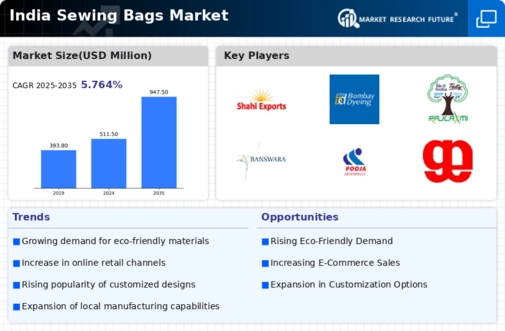Growth of Online Retail Platforms
The sewing bags market in India is experiencing a transformation due to the rise of online retail platforms. E-commerce has made it easier for consumers to access a wide variety of sewing bags, often at competitive prices. Recent statistics show that online sales in the sewing bags market have increased by approximately 25% in the last year, as consumers appreciate the convenience of shopping from home. This trend is encouraging manufacturers to enhance their online presence and invest in digital marketing strategies to reach a broader audience. The sewing bags market is thus likely to benefit from this shift towards online retail, as more consumers turn to e-commerce for their sewing needs, potentially leading to increased market penetration and brand visibility.
Increase in DIY Culture and Crafting
The sewing bags market in India is benefiting from a resurgence in the DIY culture and crafting activities. This trend has been fueled by social media platforms showcasing creative projects, which inspire individuals to engage in sewing and crafting. Recent surveys indicate that approximately 40% of urban households have taken up sewing as a hobby, leading to increased demand for sewing bags that cater to various crafting needs. The sewing bags market is witnessing a diversification of products, including specialized bags for quilting, embroidery, and general crafting. This growing interest in DIY projects suggests a robust potential for market expansion, as more consumers seek out unique and functional sewing bags to support their creative endeavors.
Urbanization and Changing Lifestyles
Urbanization in India is significantly impacting the sewing bags market. As more individuals migrate to urban areas, lifestyles are evolving, leading to a demand for practical and stylish sewing bags that cater to the fast-paced urban environment. The market data indicates that urban consumers are increasingly looking for multifunctional bags that can serve various purposes, from carrying sewing supplies to functioning as everyday bags. This shift in consumer behavior is prompting manufacturers to innovate and design products that meet the needs of urban dwellers. The sewing bags market is likely to see a rise in demand for compact, stylish, and versatile bags that align with the modern urban lifestyle, potentially driving sales and market growth.
Rising Demand for Eco-Friendly Products
The sewing bags market in India is experiencing a notable shift towards eco-friendly products. As consumers become increasingly aware of environmental issues, there is a growing preference for sustainable materials such as organic cotton and recycled fabrics. This trend is reflected in market data, indicating that the demand for eco-friendly sewing bags has surged by approximately 30% over the past year. Manufacturers are responding by innovating their product lines to include biodegradable options, which not only appeal to environmentally conscious consumers but also align with government initiatives promoting sustainability. The sewing bags market is thus likely to see continued growth as more brands adopt eco-friendly practices, potentially leading to a more sustainable future for the sector.
Influence of Fashion Trends on Product Design
The sewing bags market in India is increasingly influenced by fashion trends, which are shaping consumer preferences and product designs. As fashion consciousness rises among consumers, there is a growing demand for sewing bags that not only serve functional purposes but also reflect current style trends. Market analysis suggests that approximately 35% of consumers prioritize aesthetics when selecting sewing bags, prompting manufacturers to collaborate with designers to create trendy and fashionable products. This influence of fashion on the sewing bags market indicates a potential for innovation and creativity, as brands strive to differentiate themselves in a competitive landscape. The alignment of functionality with fashion could lead to enhanced consumer engagement and loyalty, ultimately driving market growth.





















Leave a Comment